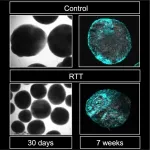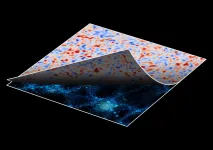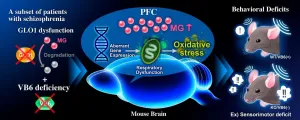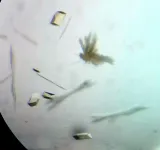(Press-News.org) Fukuoka, Japan--Medical researchers led by Kyushu University have revealed a possible underlying genetic pathway behind the neurological dysfunction of Rett syndrome. The team found that deficiencies in key genes involved in the pathology triggers neural stem cells to generate less neurons by producing more astrocytes--the brain's maintenance cells.
The researchers hope that the molecular pathology they identified, as reported in the journal Cell Reports, can lead to potential therapeutic targets for Rett syndrome in the future.
Rett syndrome is a progressive neurodevelopmental disorder characterized by impairments in cognition and coordination--with varying severity--and occurs in roughly one in every 10,000 to 15,000 female births. However, it is difficult to initially identify because children appear to develop normally in the first 6-18 months.
"Rett syndrome is caused by mutations in a single gene called methyl-CpG binding protein 2, or MeCP2. The gene was identified over two decades ago and much has been uncovered since, but exactly how the mutations cause the pathology remains elusive," explains first author Hideyuki Nakashima of Kyushu University's Faculty of Medical Sciences
In their past research, the team had identified that MeCP2 acts as a regulator for the processing of specific microRNAs to control the functions of neurons. So, they went back to investigate if that pathway was also involved in the differentiation of neural stem cells.
Compared to messenger RNA, the final template transcribed from DNA that is used by a cell to synthesize proteins, microRNAs--or miRNAs--are much smaller and act to regulate messenger RNA to make sure the cell is making the correct amount of the desired protein.
"Through our investigation, we found several microRNAs associated with MeCP2, but only one affected the differentiation of neural stem cells: a microRNA called miR-199a," says Nakashima. "In fact, when either MeCP2 or miR-199a are disrupted, we found that it increased the production of cells called astrocytes."
Astrocytes are like the support cells of your brain. While neurons fire off the electrical signals, astrocytes are there to help maintain everything else. During development, astrocytes and neurons are generated from the same type of stem cells, known as neural stem cells, where their production is carefully controlled. However, dysfunction in MeCP2 or miR-199a causes these stem cells to produce more astrocytes than neurons.
"Further analysis showed that miR-199a targets the protein Smad1, a transcription factor critical for proper cellular development. Smad1 functions downstream of a pathway called BMP signaling, which is known to inhibit the production of neurons and facilitate the generation of astrocytes," states Nakashima.
To investigate the process further, the team established a brain organoid culture--a 3D culture of neural stem cells that can mimic aspects of brain development--from iPS cells derived from patients with Rett syndrome. When they inhibited BMP, short for bone morphogenetic protein, the team was able to reduce abnormal neural stem cell differentiation.
"Our findings have given us valuable insight into the role of MeCP2, miR-199a, and BMP signaling in the pathology of Rett syndrome," concludes Kinichi Nakashima, who headed the team. "Further investigation is needed, but we hope this can lead to clinical treatments for Rett syndrome symptoms."
INFORMATION:
For more information about this research, see "MeCP2 controls neural stem cell fate specification through miR-199a-mediated inhibition of BMP-Smad signaling," Hideyuki Nakashima, Keita Tsujimura, Koichiro Irie, Takuya Imamura, Cleber A. Trujillo, Masataka Ishizu, Masahiro Uesaka, Miao Pan, Hirofumi Noguchi, Kanako Okada, Kei Aoyagi, Tomoko Andoh-Noda, Hideyuki Okano, Alysson R. Muotri, and Kinichi Nakashima, Cell Reports (2021).
https://doi.org/10.1016/j.celrep.2021.109124
About Kyushu University
Kyushu University is one of Japan's leading research-oriented institutes of higher education since its founding in 1911. Home to around 19,000 students and 8,000 faculty and staff, Kyushu U's world-class research centers cover a wide range of study areas and research fields, from the humanities and arts to engineering and medical sciences. Its multiple campuses--including the largest in Japan--are located around Fukuoka City, a coastal metropolis on the southwestern Japanese island of Kyushu that is frequently ranked among the world's most livable cities and historically known as a gateway to Asia.
Japanese astronomers have developed a new artificial intelligence (AI) technique to remove noise in astronomical data due to random variations in galaxy shapes. After extensive training and testing on large mock data created by supercomputer simulations, they then applied this new tool to actual data from Japan's Subaru Telescope and found that the mass distribution derived from using this method is consistent with the currently accepted models of the Universe. This is a powerful new tool for analyzing big data from current and planned astronomy surveys.
Wide area survey data can be used to study the large-scale structure of the Universe through measurements of gravitational lensing patterns. In gravitational lensing, the ...
Microorganisms produce natural products, for example, as disease-causing virulence factors or as defense substances against predators and competitors. A team led by Dr. Robin Teufel and first author Ying Duan from the Institute of Biology II at the Faculty of Biology of the University of Freiburg, together with researchers from the University of Bonn, have now discovered a novel enzyme that is crucial for the production of so-called bacterial tropone natural products. The researchers presented their results in the current issue of the Journal of the American Chemical Society.
Previously unknown enzyme type
Bacteria found in terrestrial and marine environments produce tropone natural products, among other things, when they interact symbiotically with plants, algae or lower animals, for ...
Methylglyoxal (MG) is a highly reactive α-ketoaldehyde formed endogenously as a byproduct of the glycolytic pathway. MG accumulates under conditions of hyperglycemia, impaired glucose metabolism, or oxidative stress. An excess of MG formation causes mitochondrial impairment and reactive oxygen species (ROS) production that further increases oxidative stress. It also leads to the formation of advanced glycation end products (AGEs) due to MG reacting with proteins, DNA, and other biomolecules, which can induce aberrant inflammation via binding to receptors for AGEs (RAGE). To remove the toxic MG, ...
This insight is the result of the close collaboration of several research groups at the Max Planck Institute for Marine Microbiology. A team around Cedric Hahn and Gunter Wegener recently discovered ethane-degrading microbes at hydrothermal vents of the Guaymas Basin at a water depth of 2,000 meters in the Gulf of California. They named it Ethanoperedens thermophilum, which means "heat-loving ethane-eater". Cedric Hahn a PhD student from the research group Molecular Ecology cultured the ethane-degrading microbes in the laboratory. Hahn, Wegener and colleagues of the research group Microbial Metabolism, Tristan Wagner and Olivier Lemaire took a closer look at these microorganisms. This collaborative work unraveled the secrets behind ...
"We have studied which temperatures are preferable and which are harmful in humans, cattle, pigs, poultry, and agricultural crops and found that they are surprisingly similar," says Senthold Asseng, Professor of Digital Agriculture at TUM. According to the study, preferable temperatures range from 17 to 24 degrees Celsius.
When does it become too hot for humans?
At high humidity, mild heat strain for humans begins at about 23 degrees Celsius and at low humidity at 27 degrees Celsius. "If people are exposed to temperatures above 32 degrees Celsius at extremely high humidity or above 45 degrees Celsius at extremely low humidity for a lengthy period of time, it can be fatal," says Prof. Asseng. "During extreme heat events with temperatures far above 40 degrees Celsius, such as those ...
Plastics are a growing problem for natural ecosystems around the globe, and in particular for our marine and freshwater environments. Rivers are the leading source of plastic pollution, as it has been estimated that they deliver several million metric tons of plastic annually to our oceans from poor land-based waste management. The problem is that the estimates made for plastics flowing from the rivers are tens to hundreds of times higher than the quantity of plastics floating on the ocean's surface. So where is all of this river-derived plastic actually going - is there a missing plastic 'sink' somewhere in the ocean? Are the estimates correct?
In a paper published ...
Originally discovered as a bacterial mode of defense against invading viruses, the remarkable ability of CRISPR-Cas9 to modify specific locations of DNA has made it a researcher favorite among gene editing tools. The ongoing effort to explore further possibilities of the CRISPR-Cas9 system is ushering in newer developments to this tool. In one of the latest refinements of the technique, as illustrated in a study published in BioDesign Research, scientists from Stanford University, USA have developed a CRISPR-Cas9 system that induces highly effective silencing of target genes.
The versatility of CRISPR-Cas9 based gene editing is largely ...
New research published in The Journal of Physiology shows that researchers have successfully repurposed two existing medications to reduce the severity of sleep apnoea in people by at least 30 per cent.
Affecting around 1.5 million adults in the UK, sleep apnoea is a condition where the upper airway from the back of the nose to the throat closes repetitively during sleep, restricting oxygen intake and causing people to wake as often as 100 times or more per hour (1).
Those with untreated sleep apnoea are more likely to develop cardiovascular disease, dementia and depression, ...
NDIANAPOLIS--Indiana University School of Medicine researchers are developing a new, noninvasive brain stimulation technique to treat neurological disorders, including pain, traumatic brain injury (TBI), epilepsy, Parkinson's disease, Alzheimer's disease and more.
"Given the increasing use of brain stimulation in human brain study and treatment of neurological diseases, this research can make a big impact on physicians and their patients," said Xiaoming Jin, PhD, associate professor of anatomy, cell biology and physiology.
When someone experiences a brain injury, nerve injury, or neurodegeneration, such as in epilepsy and TBI, there is damage to the brain which can lead to loss ...
Small children learn language at a pace far faster than teenagers or adults. One explanation for this learning advantage comes not from differences between children and adults, but from the differences in the way that people talk to children and adults.
For the first time, a team of researchers developed a method to experimentally evaluate how parents use what they know about their children's language when they talk to them. They found that parents have extremely precise models of their children's language knowledge, and use these models to tune the language they use when speaking to them. The results are available in an advance online publication ...





